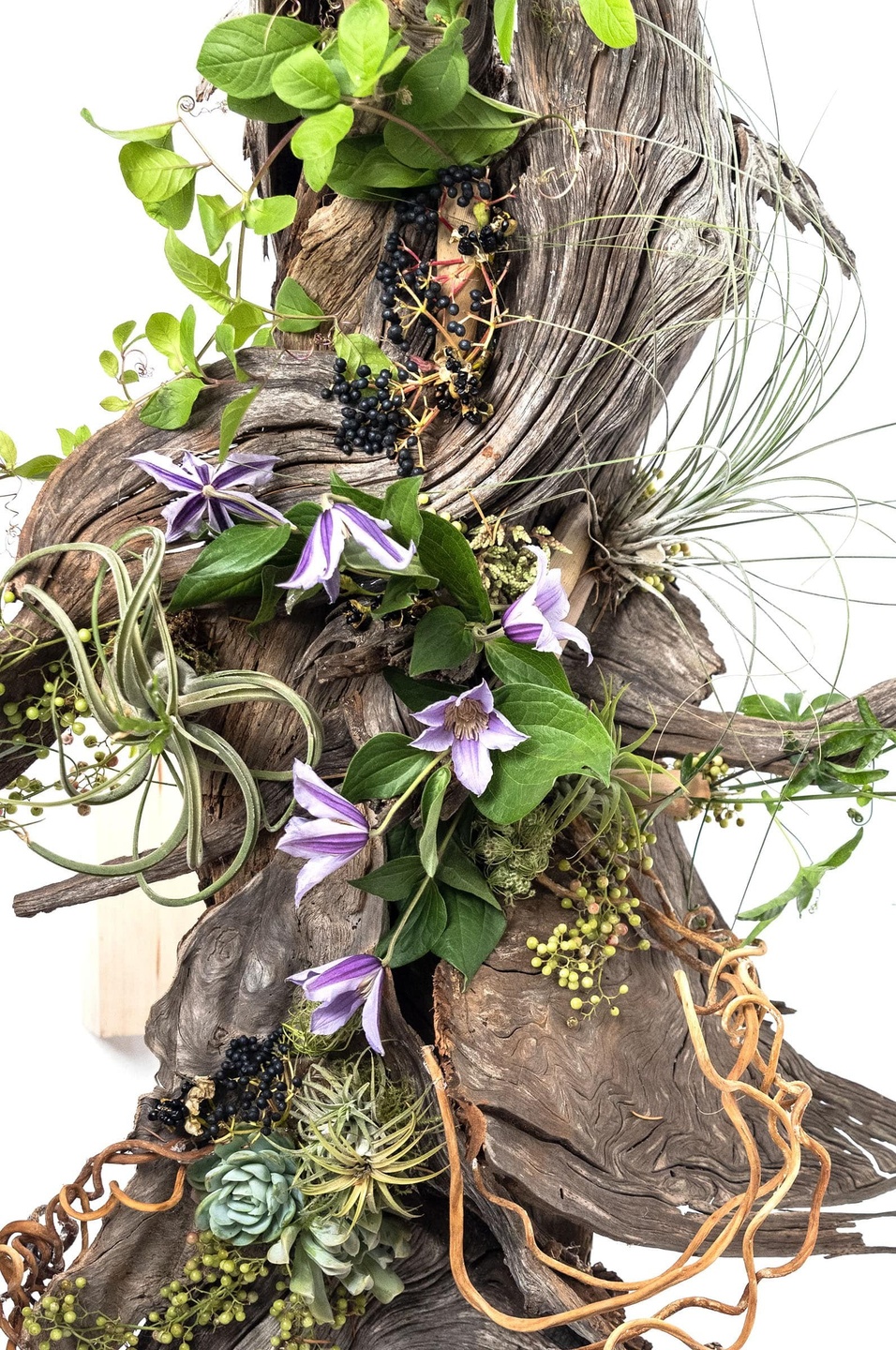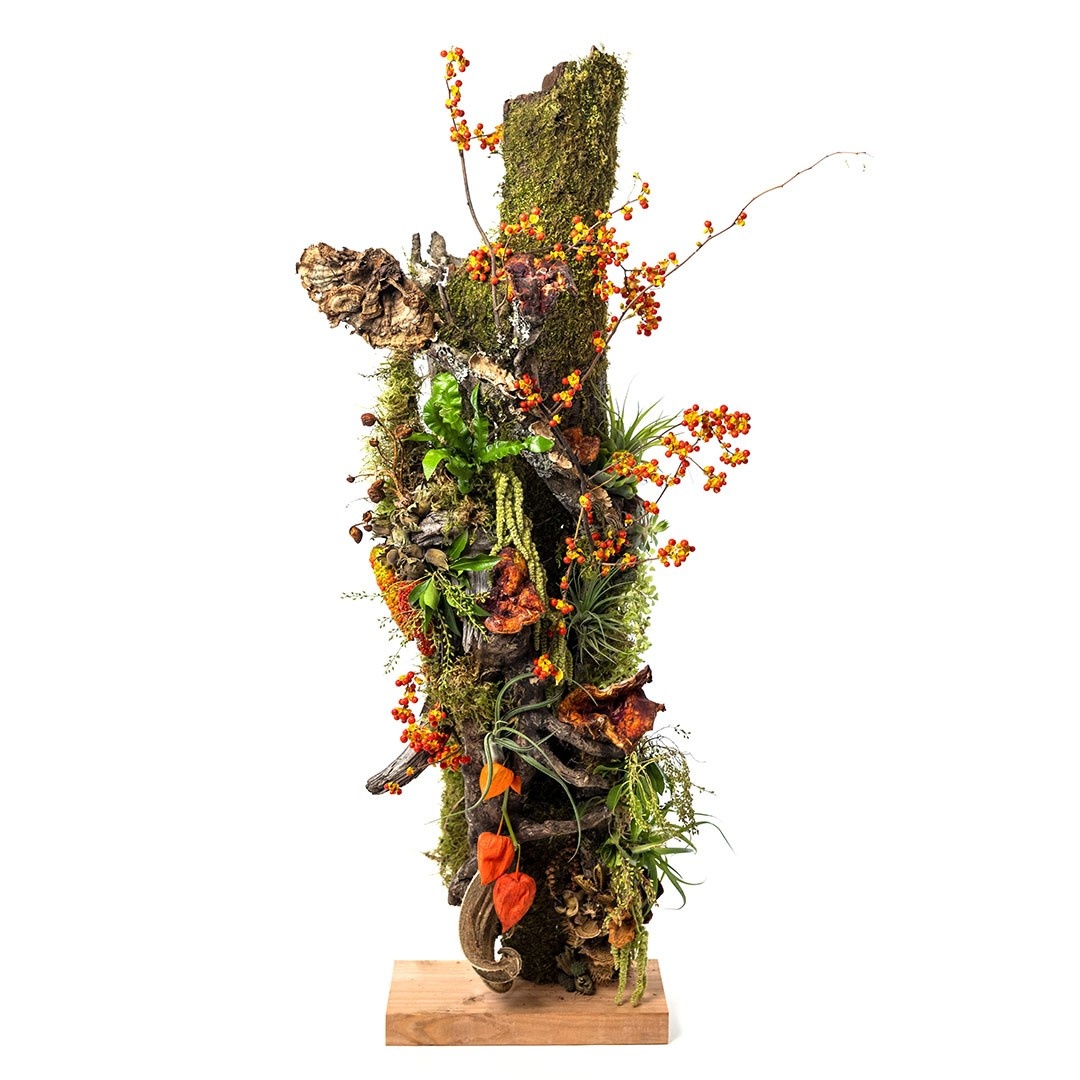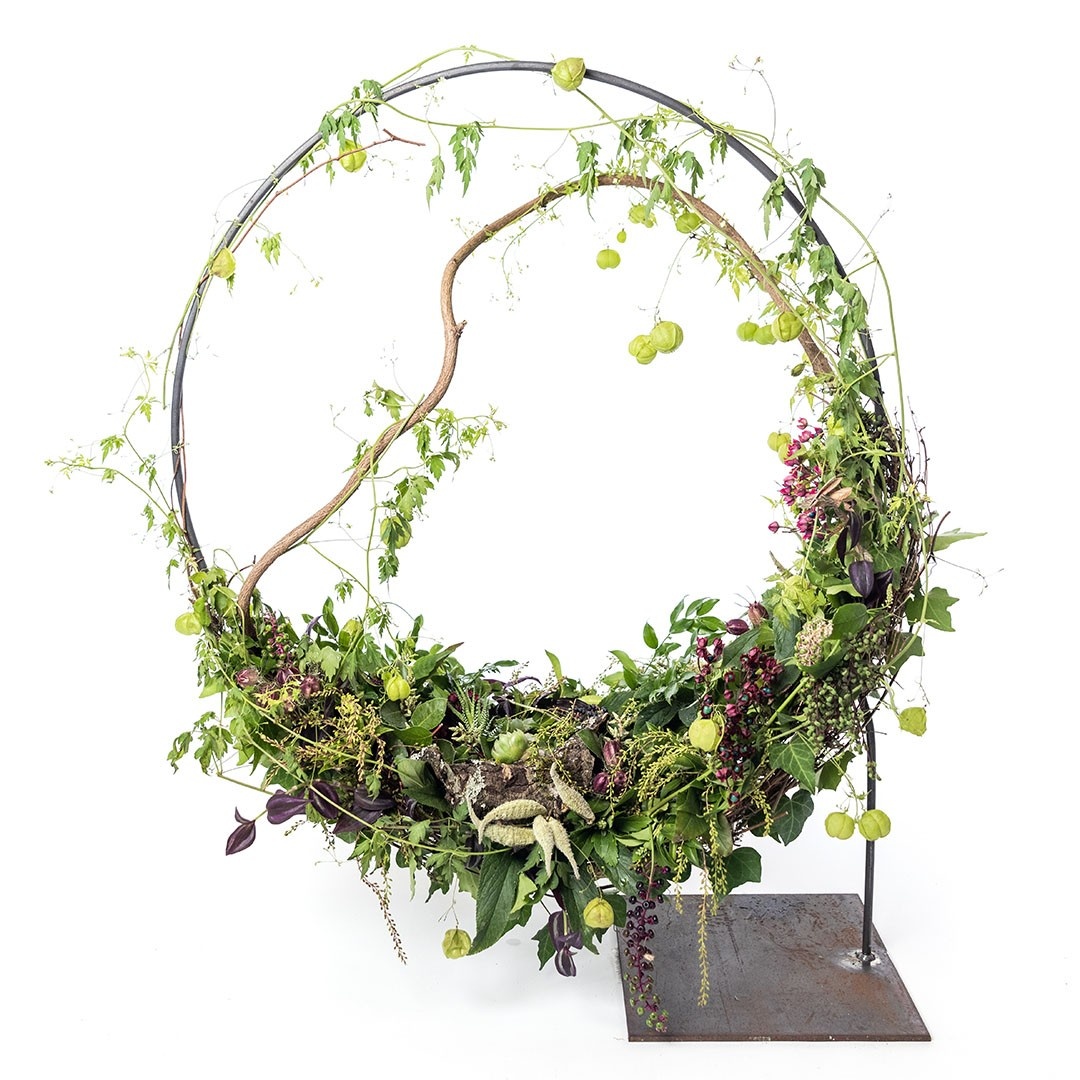Welcome to Your Free Lesson!
GET $228 OFF THE COURSEDriftwood Structure
For the structure: 1x thick piece of wood, 1x thin piece of wood, 2x 3/4-in dowels, 2x screws, drill, wood glue, water tubes, hot glue gun, zip ties (optional)
For the design: 5x driftwood pieces, dried seaweed, bamboo husks, clematis, passion vine, tillandsia, spider plant babies, cobaea vine, seedpods of belamcanda, viburnum and eucomis, moss, succulents, pepper berries
Plan ahead: Before starting your design, source or build your stand. I built my own using wooden pieces and dowels, but if you’re able to purchase one, this works as well. If building your own, cut your wood pieces and dowels down to whatever size you prefer for the design you have in mind.
Drill two holes spaced four or five inches apart and about three-quarters of the way down into the wood. Each hole should be just large enough to fit your dowels into. Make sure the holes you drill for the dowels are perfectly straight. This ensures the dowels will remain parallel. Cover the ends of your dowels with wood glue and press them into the holes. Place the thin piece of wood atop both dowels. Grab your screws and drill them through the wood and into each dowel to fasten the pieces together. Overall, you’re looking for something with height that will hold your design safely when placed on top. Make sure the base of the stand is heavy enough to support the rest of the design. We don’t want it to tip over!
Prepare the base of your design: Gather your pieces of driftwood and place them atop each other, creating a shape and structure to your liking. Use hot glue to adhere the pieces together across several connection points. Alternatively, you could use a drill and zip ties to create a more secure connection. With this method, carefully drill a few holes at your pre-determined connection points and thread your zip ties through the holes. Tighten the zip ties and secure the pieces into place and cut off the excess. From here, position and rest the base atop your stand. If you’d like something more stable, drill some holes through the base of the driftwood and use zip ties to secure it to your stand. If you’re planning to transport your finished design, I would highly recommend this approach.
Decorate with textures and botanicals: I used passion vine for movement and seaweed and tillandsia to carry over the coastal theme. For materials requiring a water source, wrap bamboo husks around your water tubes and secure with hot glue. The husks create a more organic look when placed around the driftwood.
“Françoise has taught me to be curious, to cultivate my artistic voice and I've really learned to see the floral and plant world with new eyes. She will inspire you and continue to elevate the world of floral design ever more!”
Susan McLeary
So What's This Course About?
One of my more recent explorations has been designing vertically instead of horizontally. By creating these vertical structures, I'm able to take my designs to new heights — literally! The results are truly striking. If you've taken my course on Sustainable Woodlands, you've learned about my foam-free approach to design, and the mechanics taught in that course can easily be applied to these new lessons. That being said, I typically don't use materials requiring a water source with these structures. It makes them a lot more permanent!
If you haven't taken my Sustainable Woodlands course, let's talk about floral foam. These past few years, a growing number of florists in the industry have become increasingly concerned about the environmental impact of floral foam: an element of design that has been crucial to our field for the past 60 years. After doing a little research, it was easy to see why. Did you know that one block of floral foam is the equivalent of ten plastic shopping bags? This little green block is non-biodegradable, non-recyclable and toxic to both humans and animals. That being said, its popularity is understandable. It's lightweight, easy to cut and mold, and holds up to two quarts of water. It's the perfect water source. Knowing all of this, I wanted to ditch the foam without losing any of the benefits. This is what my Sustainable Woodlands course is all about: foam-free mechanics that have structure, shape, and above all, supports materials that require a water source.
Structural Woodlands takes some foam-free cues from that course, but it also stands on its own, offering four new woodland-inspired designs, all ready for your next large-scale event, special occasion, or dinner party. These lessons were created to inspire, teach you new mechanics, and help you build your repertoire so you may offer more to your clients and grow your knowledge of, and confidence in, floristry all while being a bit kinder to the world around us.
Let's start at the beginning
What will this course teach you?
If you haven't taken any of my previous courses, don't worry! Structural Woodlands is totally accessible to all ranges of floral design experience and skill. In this course, you will learn how to create four unique foam-free structural designs. These lessons were developed using my latest mechanics and techniques to create structure, shape, and above all, to support materials that require a water source...all without using floral foam.
I hope this new series will spark your curiosity and open your eyes to seeing the possibilities of environmentally conscious design.

Want to see what you'll master?

Driftwood
Showcasing the natural beauty of driftwood, this structure utilizes seaweed and tillandsia along with a hidden natural water source using water tubes.

Vertical Bark
Bringing the natural world to your space in its purest form, I've created a design highlighting one of my favorite design materials: bark.

Circular
Always looking to incorporate movement, I was immediately drawn to the idea of using a ring to showcase some of my favorite foliage in a most unique way.

Partial Frame
While at a workshop in France, I noticed another instructor using a partial frame in their design. This is my own woodland take on that inspired idea!
“It's hard to put into words how fantastic Françoise is as a teacher and a designer. She's truly changed the way I look at floral design. There's no one that looks at botanical materials the way that Françoise does.”
Alison Ellis
I can't wait to see what you make!
These four structural woodland lessons will inspire you to see with new eyes and to tap into your own passion for floral design, all while gaining confidence in becoming a more environmentally conscious creator within the natural world.
This is a wonderful time of year to find and use woodland materials and to practice and share your creations with family, friends, and clients. Taking time for yourself to pursue what you love and learn new skills is a fantastic way to reinvigorate your passion and expand your floral offerings.
Post your design creations on social media, and use the hashtag #francoisewoodlands for a chance to be featured! Voilà!

Don't forget to check out my other courses!
From Woodland Design to Botanical Wearables, I have a wide selection of online tutorials to explore. All of my courses will help elevate your craft, with a continued focus on the underlying mechanics that make every design creation truly sing.
LEARN MORE